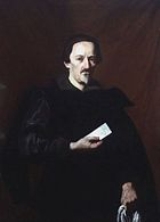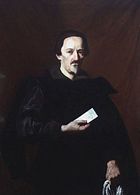
Vincenzo Giustiniani
Encyclopedia

Bassano
-Places:*Communes in Italy:**Bassano Bresciano, in the Province of Brescia**Bassano del Grappa, in the Province of Vicenza**Bassano in Teverina, in the Province of Viterbo**Bassano Romano, in the Province of Viterbo**San Bassano, in the Province of Cremona...
by Vincenzo and his brother, Cardinal Benedetto
Benedetto Giustiniani
Benedetto Giustiniani was an Italian clergyman who was made a cardinal in the consistory of 16 November 1586 by Pope Sixtus V....
, and for his patronage of the artist Caravaggio
Caravaggio
Michelangelo Merisi da Caravaggio was an Italian artist active in Rome, Naples, Malta, and Sicily between 1593 and 1610. His paintings, which combine a realistic observation of the human state, both physical and emotional, with a dramatic use of lighting, had a formative influence on the Baroque...
.
Biography
Vincenzo's father, Giuseppe Giustiniani, had been the last GenoeseGenoa
Genoa |Ligurian]] Zena ; Latin and, archaically, English Genua) is a city and an important seaport in northern Italy, the capital of the Province of Genoa and of the region of Liguria....
ruler of the Aegean island of Chios
Chios
Chios is the fifth largest of the Greek islands, situated in the Aegean Sea, seven kilometres off the Asia Minor coast. The island is separated from Turkey by the Chios Strait. The island is noted for its strong merchant shipping community, its unique mastic gum and its medieval villages...
, which had been a family possession for centuries. In 1566 the island was lost to the Ottomans, and Vincenzo and his elder brother Benedetto were taken by their father to Rome, where an uncle was already a cardinal. Giuseppe Giustiniani became a banker, and by his death in 1600 was financier to the Vatican and one of the richest men in Rome.
Vincenzo Giustiniani followed his father into the family business, while Benedetto
Benedetto Giustiniani
Benedetto Giustiniani was an Italian clergyman who was made a cardinal in the consistory of 16 November 1586 by Pope Sixtus V....
entered the Church and became a cardinal himself, 16 November 1586. Both brothers were keen art patrons, and the collection they established became one of the most important in its age. On Giustiniani's death - Benedetto died in 1621 - it contained over 300 paintings (15 by Caravaggio) and more than 1200 pieces of sculpture, and the various catalogues constitute an invaluable resource for early 17th century art. In 1631, the Galleria Giustiniani was published under supervision of Joachim von Sandrart
Joachim von Sandrart
Joachim von Sandrart was a German Baroque art-historian and painter, active in Amsterdam during the Dutch Golden Age.-Biography:Sandrart was born in Frankfurt, but the family originated from Mons...
, in the form of a compilation of engravings of the family's gallery of statuary, most notably the Athena Giustiniani
Athena Giustiniani
The Parian marble Athena Giustiniani or Giustiniani Minerva is an Antonine Roman marble copy of a Greek sculpture of Pallas Athena, of the late fifth-early fourth century BCE....
, and the Giustiniani Hestia
Giustiniani Hestia
The Giustiniani Hestia is a finely-executed marble sculpture, a perhaps Hadrianic Roman copy of a Greek bronze of about 470 BCE, now in the Torlonia Collection , Rome, but named for its early owner, marchese Vincenzo Giustiniani...
.
Giustiniani followed interests in many other fields, writing essays in architecture, music, and art, as well as on such practical matters as hunting, travel, and horse trading
Horse trading
In the original sense, Horse trading is the buying and selling of horses, also called "Horse Dealing". Due to the difficulties in evaluating the merits of a horse offered for sale, the selling of horses offered great opportunities for dishonesty...
. A friend and neighbour of Caravaggio's first patron, cardinal Francesco Maria Del Monte
Francesco Maria Del Monte
Francesco Maria Del Monte, full name Francesco Maria Bourbon Del Monte Santa Maria, was an Italian Cardinal, diplomat and connoisseur of the arts...
, he extended his own friendship to the artist, purchasing Saint Matthew and the Angel when it was rejected by church officials for its perceived lack of decorum.
He died in Rome in 1637.
Legacy

Prussia
Prussia was a German kingdom and historic state originating out of the Duchy of Prussia and the Margraviate of Brandenburg. For centuries, the House of Hohenzollern ruled Prussia, successfully expanding its size by way of an unusually well-organized and effective army. Prussia shaped the history...
acquired over 160 paintings, the most important of which were destined for museums in Berlin
Berlin
Berlin is the capital city of Germany and is one of the 16 states of Germany. With a population of 3.45 million people, Berlin is Germany's largest city. It is the second most populous city proper and the seventh most populous urban area in the European Union...
. Today the Berlin Gemäldegalerie houses 43 paintings from the Giustinani collection, while other works are to be found in Potsdam’s Neues Palais and Bildergalerie Sanssouci
Sanssouci
Sanssouci is the name of the former summer palace of Frederick the Great, King of Prussia, in Potsdam, near Berlin. It is often counted among the German rivals of Versailles. While Sanssouci is in the more intimate Rococo style and is far smaller than its French Baroque counterpart, it too is...
. Further examples can be seen in the National Gallery, London
National Gallery, London
The National Gallery is an art museum on Trafalgar Square, London, United Kingdom. Founded in 1824, it houses a collection of over 2,300 paintings dating from the mid-13th century to 1900. The gallery is an exempt charity, and a non-departmental public body of the Department for Culture, Media...
, the Hermitage Museum
Hermitage Museum
The State Hermitage is a museum of art and culture in Saint Petersburg, Russia. One of the largest and oldest museums of the world, it was founded in 1764 by Catherine the Great and has been opened to the public since 1852. Its collections, of which only a small part is on permanent display,...
, St. Petersburg and the Kunsthistorisches Museum
Kunsthistorisches Museum
The Kunsthistorisches Museum is an art museum in Vienna, Austria. Housed in its festive palatial building on Ringstraße, it is crowned with an octagonal dome...
, Vienna. More paintings from the collection have been traced to collections and museums in Europe and the United States.

